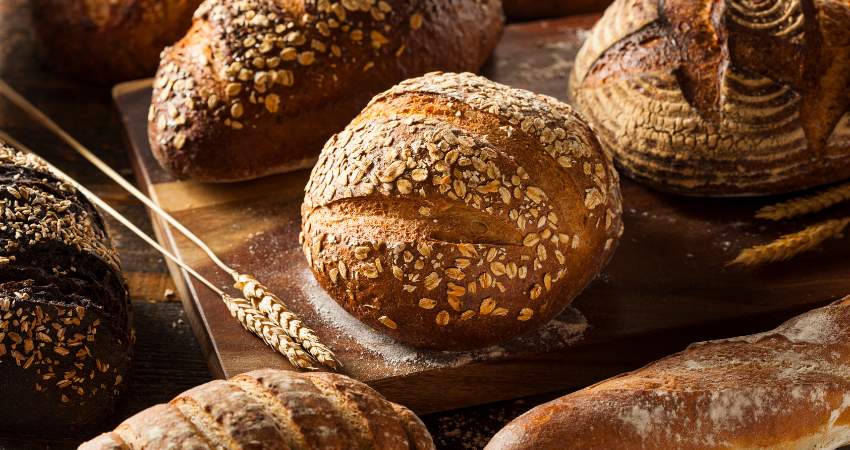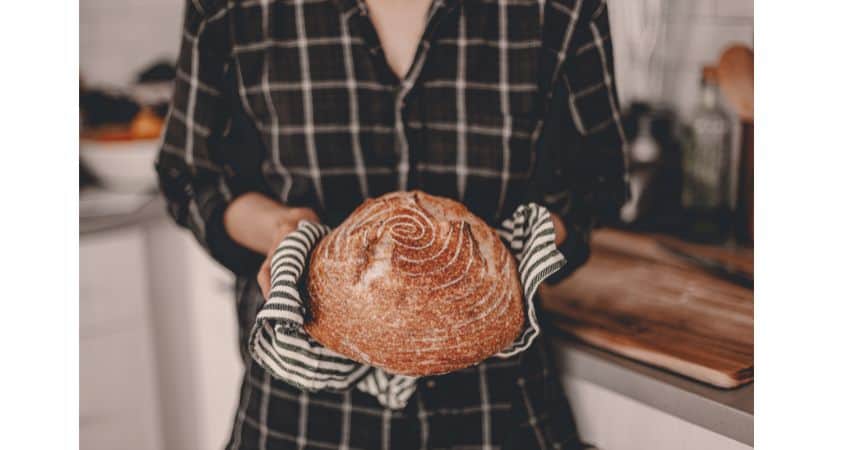Is Homemade Bread Healthier Than Store Bought?
In the store some bread is fresh from the store’s bakery, while others are shipped from outside sources. You might be wondering about the ingredients and asking, is homemade bread healthier than store bought?
Homemade bread is healthier than store bought bread. Store bought is processed and homemade is not. This removes most of the fiber, minerals and vitamins. Store bought has to be supplemented to replace the removed natural nutrients. Store bought contains unhealthy additives and preservatives homemade bread doesn’t contain.
This article will explain in more detail why homemade bread is healthier. In addition, I’ll compare how the bread is made along with the ingredients, nutrients and vitamins.
Why Homemade Bread Is Healthier Than Store Bought

As a Certified Health Coach many of my clients ask my about healthy food including bread. I have researched this topic in the past and continue to do so. Let’s examine what I have found in my research.
Flour
- The manufacturers of store bought bread uses processed flour. The refined flour has a lighter texture and a longer shelf life. The processing removes most or all of the fiber, minerals and vitamins. It then has to be enriched to add some of the minerals and vitamins back in.
- Homemade bread uses real flour and is not processed or bleached. Flour is an excellent source of protein, fiber and vitamins. In addition, it’s low in fat and cholesterol.
- Typical flour in store bought bread are wheat based and contain gluten. For this reason, it must be avoided by people with celiac disease. Homemade bread can be made gluten free and healthier for people with celiac disease.
Before processing, the grain contains three parts:
- Outer layer (the bran)
- Middle layer (endosperm)
- Inner layer (germ)
During the refining process the bran and germ are removed and the endosperm is the part remaining1. The bran and the germ contain the most nutrition, fiber and antioxidants. The endosperm is mostly composed of starchy carbs and is low in nutrients.
The starchy carbs can cause spikes in blood sugar after eating them. Frequent increases in blood sugar can lead to insulin resistance, type 2 diabetes and weight gain2.
Bleached flour gives it a super white color. Homemade bread can use unbleached which is healthier.
Disclaimer: Some links in this article are affiliate links which means I may earn a small commission at no extra cost to you. As an Amazon associate I earn from qualifying purchases.
I’ve been using a Cuisinart bread maker machine at home. Amazon sells it and others at affordable prices which you can check out here, Bread Maker Machines.
Added Ingredients
- Store bought bread contains added ingredients that are not real food. Some of these added ingredients are dough conditioners, preservatives, added sugars, artificial coloring and flavoring and GMOs (a genetically modified organism).
- Homemade bread can be made with only four ingredients – flour, yeast, water and salt. Added sugars can be omitted along with the artificial coloring and flavoring. Homemade bread won’t have the dough conditioners.
Dough conditioners: They are used by manufacturers of store bought bread because they make the process of manufacturing bread in commercial machinery cheaper and faster3.
Preservatives: They help the bread from spoiling faster while sitting on trucks and store shelves. Real homemade bread is made fresh and eaten within days unless you freeze it4.
Added Sugars: Most manufacturers add high fructose corn syrup and other artificial sweeteners like Sucralose. The breads labeled “light” often contain much more sugar to improve the taste. The sugar in homemade bread can be controlled or not added at all.
GMOs: Most store breads contain at least one GMO5. Homemade bread doesn’t contain any ingredients that had their genetic code changed in some way. Some GMOs are:
- Corn oil
- Soybean oil
- Soy flour
- Corn starch
- Soy lecithin
Artificial Coloring and flavoring: Artificial colors are added to food for the following reasons:
- Enhance the color.
- To limit color loss due to storage, light or temperature.
- Provide color to colorless foods.
They are made of nitrogen, complex hydrocarbons and sulfur ions. Without them cola wouldn’t be brown and mint ice cream wouldn’t be green6.
Sodium
Store bought bread contains more sodium than homemade. One slice of white bread from a store contains approximately 147 mg of sodium. That adds 294 mg per sandwich and 588 mg if you have two sandwiches.
The sodium content can be controlled or not added at all which brings me to the next section.
Customization
When making homemade bread, you’re in control of the ingredients. Adding mixed nuts or other healthy ingredients to the bread increases the vitamins and mineral content making it healthier.
Picking the best flour is probably the biggest difference between store bought or homemade7.
Trans Fats
Homemade bread can be made free of trans fats unless you add vegetable shortening or margarine. Trans fat has zero benefits and should be avoided at all costs.
Unfortunately, it can still be found in some food. In addition to increasing bad cholesterol, it can cause inflammation and insulin resistance which aggravates blood pressure more8.
Relaxation
Some people love to bake and it makes them happy. Do you love the smell inside your home when something is baking in the oven? For me it’s very calming and relaxes the mind. making homemade bread can do the following:
- Feel happier.
- Creating a sense of achievement.
- Feel more relaxed.
- Less anxiety.
- Feeling a purpose.
- Increased confidence
A recent review of past studies found positive benefits from cooking and baking beyond nutrition.
In addition to the benefits above, they concluded people were distracted from everyday issues and changed their moods from negative to positive9.

Make Homemade Bread Healthier
Increase the vitamins nutrients and antioxidants of homemade bread by the following:
- Use whole grain flour.
- Add seeds like flax seeds and sunflower.
- Add mixed nuts.
- Oatmeal bread can be made with rolled oats and oat flour.
- For gluten free bread use almond or hazelnut flours.
- Use healthy oils like olive or almond oil.
- Add blueberries which are packed with antioxidants.
- Soak the flour in liquid before combining it with other ingredients to avoid dryness and crumbling.
Keto Bread Tip: Great News! Did you know, you don’t have to give up your favorite bread, pizza or sandwiches to follow a 100% Keto diet. Find out more in the KetoBreads website by clicking here, Keto Breads.
If you have any questions to ask me about this article don’t hesitate to comment below or email us. You can find an email on our contact page.
Read Next – More Articles on Anti Aging Foods!
Why Does Chicken Pop In The Microwave?
These Strawberry Varieties Are The Sweetest
4 Delicious Ways To Cook Fried Eggs
How To Mince Garlic Without a Mincer
- ScienceDirect: Grain Processing [↩]
- National Center for Biotechnology Information: A review of recent evidence relating to sugars, insulin resistance and diabetes [↩]
- Wikipedia: Dough Conditioner [↩]
- Michigan State University: Preservatives – Keeping our foods safe & fresh [↩]
- Purdue University: What are GMOs? [↩]
- FDA: Overview of Food Ingredients, Additives & Colors [↩]
- NutritionData: Flour Nutrition Information [↩]
- Harvard Health: The truth about fats: the good, the bad, and the in-between [↩]
- National Center for Biotechnology Information: Psychosocial Benefits of Cooking Interventions: A Systemic Review [↩]
